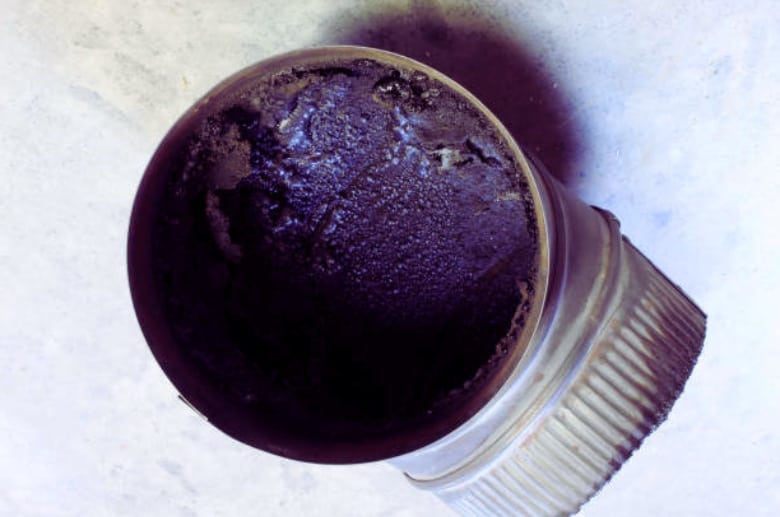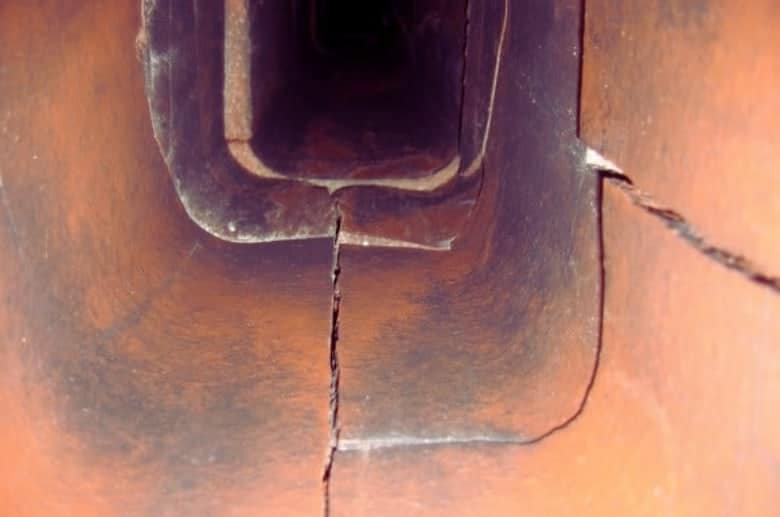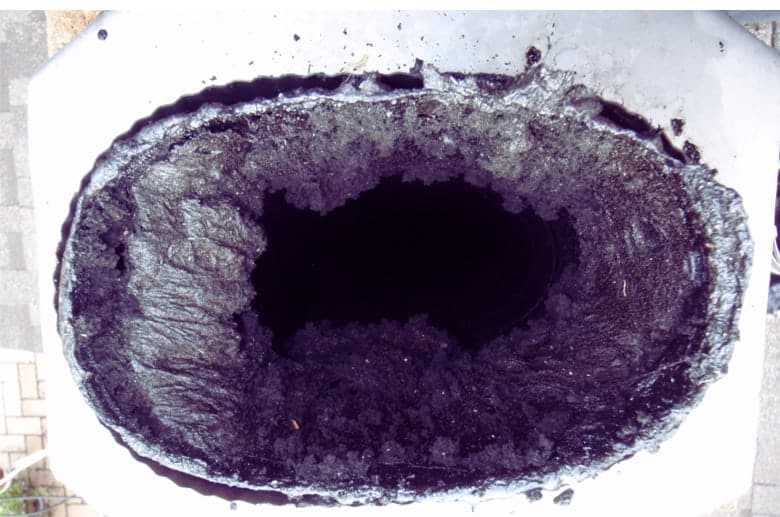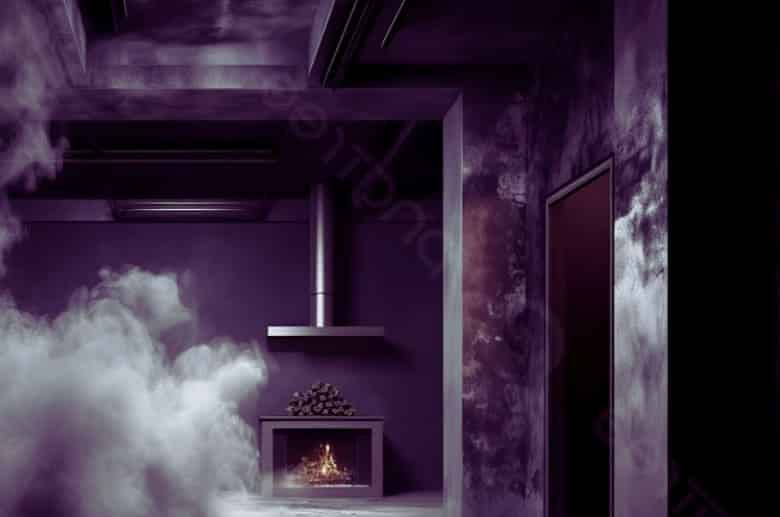The chimney liner plays a crucial role in ensuring that you have a safe home, free from toxic gases and combustion byproducts. It also protects the chimney structure from damage caused by heat, moisture, and corrosive elements.
Ensure your chimney liner is well-maintained to avoid potential problems that could compromise your safety and the integrity of your chimney.
This guide explores common problems with chimney liners and the key indicators to be aware of. We also highlight the underlying causes behind these problems and offer valuable insights and effective solutions. Let’s jump into it!
1. Creosote Buildup

Creosote is a tar-like substance that adheres to the inner walls of your chimney and forms due to incomplete combustion. This buildup poses immediate fire dangers and can lead to long-term damage to your flue liner and overall structure.
While many homeowners are unaware of the dangers of creosote, they are also often uninformed about chimney liner repair methods, which can help in restoring the functionality and safety of the chimney. Part of ensuring the safety and longevity of your chimney involves selecting the right chimney liner.
The right liner not only provides an additional layer of protection but also enhances the efficiency of your chimney.
According to the EPA, creosote in chimneys is responsible for 30% of residential fires in the U.S. This alarming figure emphasizes the urgent need to address the problem proactively.
Besides immediate fire risks, creosote also compromises the integrity of your chimney liners. When excessively accumulated, creosote reduces the flue’s diameter, inhibiting proper airflow and potentially causing smoke to back up into your living space.
Moreover, the highly corrosive nature of creosote can accelerate the deterioration of chimney liners, leading to costly repairs or replacements.
——
Do You Need to Hire Chimney & Fireplace Expert?
Get free quotes from qualified experts near you. No commitment required!
——
Tips for Preventing and Removing Creosote Buildup
Below are effective tips to help you prevent and remove creosote buildup:
Burn Seasoned Wood
Properly seasoned wood has a lower moisture content, which leads to cleaner combustion and reduced creosote formation. We highly recommend wood that has been properly seasoned for at least 6 to 12 months with a moisture level below 20% for optimal burning.
Regular Chimney Inspections
Ensure you schedule your chimney inspection at least once a year, ideally before the start of the heating season. This will help identify issues like creosote build-up early on and address them before they become serious hazards.
Annual Chimney Sweeps
Consult a chimney expert’s services to maintain a safe and efficient liner. Chimney sweeps have the tools and expertise to safely and effectively remove creosote buildup.
They also conduct inspections during their visits to identify potential flue liner damage, ensuring your chimney system operates safely and efficiently.
4. Proper Burning Techniques
Proper burning techniques can significantly reduce creosote buildup and enhance your fireplace’s efficiency. Burn fires at higher temperatures, as this helps burn off creosote before it can accumulate.
Ensure proper airflow by opening the damper fully for adequate oxygen supply.
2. Cracks and Deterioration

Chimney liners are essential for safety and efficiency but are not immune to wear and tear. Cracks and deterioration can develop over time, compromising the integrity of your chimney system. But why do they occur in the first place? Here are some of the causes:
Exposure to Extreme Temperatures
Chimney liners are designed to withstand high temperatures. However, extreme temperatures exceeding 1,700 degrees Fahrenheit can lead to thermal stress and cause cracks to form. This is especially true during high-intensity fires, such as those fueled by large amounts of wood or other combustible materials.
Moisture Accumulation
Excess water can penetrate your chimney liner, leading to erosion, freeze-thaw cycles, and the degradation of liner materials.
Corrosive Flue Gases
Corrosive flue gases, such as sulfur dioxide (SO2) and nitrogen oxides (NOx), can accelerate the deterioration of chimney liners, particularly those made of masonry materials. These gases react with the liner materials, causing them to weaken and crack.
Consequences of Cracks and Gaps on Chimney Liner
Cracked and deteriorated chimney liners have several effects on your home. They include the following:
- Increased risk of chimney fires as heat and embers reach surrounding combustible materials
- Compromised ventilation leads to the accumulation of dangerous gases like carbon monoxide within your living spaces.
- Structural damage from water infiltration weakens the chimney’s structural integrity over time.
- Reduced efficiency occurs due to disrupted airflow.
Tips for Detecting and Repairing Cracks and Gaps
Here are helpful tips to assist you in locating and repairing cracks and gaps in your chimney liner:
- Regular Inspections: A certified professional team can perform thorough assessments using specialized equipment. If the damage is extensive, the professionals might suggest suitable options like chimney relining to restore the chimney liner.
- Use a Flashlight: Shine a bright flashlight into your chimney daily to check for any visible cracks or gaps.
- Listen for Unusual Sounds: It could indicate a structural issue if you hear unusual sounds, like falling debris into your firebox from your chimney.
- Monitor Performance: If you notice increased smoke in your home or reduced heating efficiency, it might be due to cracks compromising proper ventilation.
3. Corrosion
Corrosion in chimney liners is primarily triggered by exposure to corrosive flue gases, which are byproducts of combustion. These gases react with the liner materials, gradually weakening them and leading to structural damage.
However, it’s important to note that not all corrosion is equal. Let’s explore the different types of corrosion and their respective impact on the chimney walls.
——
Do You Need to Hire Chimney & Fireplace Expert?
Get free quotes from qualified experts near you. No commitment required!
——
Acidic Corrosion
This is the most common corrosion type in most homes, mainly contributed by acidic flue gases like sulfur dioxide (SO2) and nitrogen oxides (NOx). When combined with moisture, these acidic solutions attack the liner materials, causing thinning and pitting.
Crevice Corrosion
As the name suggests, crevice corrosion occurs in gaps, crevices, or confined spaces within a chimney liner. When moisture accumulates in these areas, it creates an environment conducive to corrosion.
Over time, this corrosive process leads to thinning, pitting, and deterioration of the liner materials, specifically within these crevices.
Galvanic Corrosion
You’ll mostly experience this corrosion if your chimney liner is constructed using different metals. Galvanic corrosion occurs when two metals come into contact with an electrolyte, such as moisture or humidity.
When these metals touch, an electrochemical reaction occurs, leading to corrosion of the less noble (more reactive) metal.
Tips for Preventing and Repairing Corrosion
Here are some valuable tips to help you prevent and address corrosion effectively:
- Use corrosion-resistant materials like stainless steel.
- Ensure proper chimney ventilation to minimize the accumulation of corrosive flue gases.
- Schedule annual chimney inspections to detect early signs of corrosion.
- Prompt repairs to prevent further deterioration. Ignoring corrosion can lead to more extensive damage and costly repair.
- Prevent moisture accumulation by addressing leaks.
4. Obstruction

This refers to blockage or hindrance within the chimney liner that restricts smoke, gases, and airflow. Obstruction impedes the efficient operation of your fireplace or heating appliance and poses safety risks by preventing the proper venting of combustion byproducts.
Here are the various causes or types of obstructions:
1. Soot and Debris Accumulation: Over time, soot, creosote, and debris from previous fires can accumulate in the chimney liner, narrowing the flue and obstructing airflow.
2. Breakage or Deterioration of Liner Parts: If liner components break or deteriorate, they can obstruct the passage of smoke and gases.
3. Bird or Animal Nests: Birds, rodents, and other animals can build nests within the chimney liner, blocking the flue and posing fire and health risks.
Implications of Obstructions On Chimney Liner
Obstructed chimney liners can have various effects on your chimney’s performance. Some of these implications include the following:
Impaired Draft
An obstruction restricts the airflow within the chimney, resulting in a poor draft. This makes starting and maintaining fires challenging and leads to inefficient combustion.
Smoke Backflow
When an obstruction hinders the chimney’s airflow, it causes smoke and gases to flow back into your living space instead of being vented outside. This causes discomfort and poses health risks due to exposure to harmful particles.
Carbon Monoxide Exposure
Blocked chimney liners lead to the accumulation of carbon monoxide indoors. This gas is highly toxic and can result in severe health consequences, including headaches, dizziness, nausea, and, in extreme cases, death.
Increased Fire Hazard
If an obstruction catches fire, it can quickly become a house fire and spread to other parts of your home, amounting to huge losses and significant danger to your family.
Tips for Detecting and Removing Obstructions
Here are tips for detecting and removing obstructions:
- Listen for unusual sounds
- Inspect the chimney cap and screen
- Check the fireplace performance
- Schedule inspections with a contractor
5. Improper installation
Improper installation of chimney liners can lead to various problems that compromise the safety and functionality of your chimney system. Here are the common construction problems and their effects:
Incorrect Sizing
An incorrectly sized chimney liner can lead to poor draft, inefficient combustion, and increased creosote buildup. Ensure you get the correct chimney liner for your heating appliances so your chimney works efficiently.
Lack of Insulation
Neglecting proper insulation within the chimney liner can lead to moisture-related problems. Moisture can condense within the liner, promoting corrosion and deterioration over time.
Improper Connection Joints
Inadequately sealed or improperly connected joints can create risks and inefficiencies. Gas and smoke leaks can occur at these joints, compromising indoor air quality, allowing toxic gases to enter your living space, and increasing the risk of chimney fires.
Wrong Material Selection
Selecting the wrong liner material for your heating appliance can lead to premature deterioration due to exposure to corrosive gases or excessive heat. Wrong materials can also lead to rapid cracks, leaks, and chimney fires.
——
Do You Need to Hire Chimney & Fireplace Expert?
Get free quotes from qualified experts near you. No commitment required!
——
Tips for Ensuring Proper Installation of Chimney Liners
Here are essential tips to guide you in ensuring the correct and effective installation of chimney liners:
- Use a professional chimney service
- Properly size your chimney liner
- Insulate the chimney liner to prevent moisture buildup
- Seal all connections and joints
Signs of Problems With Chimney Liners
If you use a fireplace or wood-burning stove, watch out for these red flags that might indicate issues with your chimney liners:
1. Reduced Fireplace Efficiency With Excessive Smoke

If your fireplace is not drawing smoke properly or you constantly have to deal with smoky indoor air, it could indicate that the chimney liner is in bad condition.
2. Rapid Accumulation of Creosote
When a chimney liner is not functioning correctly, it can lead to the inefficient release of smoke and gases, causing creosote to build up much faster than usual.
3. Water Leakage in and Around the Chimney
A properly functioning liner should keep moisture out of your chimney and home. If you notice water stains on your walls or ceiling near the chimney or find dampness in your fireplace, it could indicate a breach in the liner.
4. Cold Drafts Even When the Fireplace Isn’t in Use
A properly working liner should seal off the chimney when the fireplace is not in use, preventing cold air from entering your living space. But if you feel drafts or notice a drop in indoor temperature near the fireplace, there’s likely a breach or damage in the liner.
5. Visible Cracks or Pieces of the Liner in the Fireplace or Hearth
Over time, liners can deteriorate due to exposure to extreme temperatures and corrosive combustion byproducts. Eventually, parts of the liner can break away and fall. These pieces pose safety hazards and should be addressed immediately to prevent further damage.
Conclusion
Staying vigilant about potential problems with chimney liners is essential for the safety and efficiency of your fireplace or wood-burning stove.
You can take proactive steps by scheduling regular inspections and cleanings with a reputable company, investing in proper ventilation, and promptly addressing signs of deterioration.
Also, by prioritizing your chimney liner cleaning, maintenance, and timely repairs, you ensure a warm and inviting atmosphere and the security of your home and loved ones.






